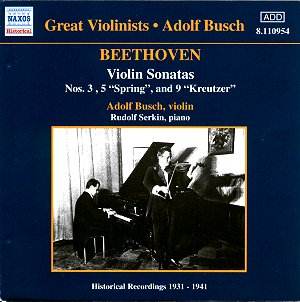This new Naxos release is another of the 'Great Violinists'
archive recordings, but the series title is in this case something of
a misnomer, as it unjustly ignores the fine pianist Rudolf Serkin (1903-1991).
Serkin, himself a fine soloist and chamber musician, is just as important
as his colleague in this violin and piano partnership, which is regarded
as one of the great string duos of the 20th century. The association
between Serkin and Busch originated from Busch’s large circles of chamber
music players (including the Busch Quartet), and it was through these
meetings that a permanent working arrangement with Serkin eventually
arose. At first, the partnership seemed unlikely - Busch, at 29, was
already widely regarded in musical society, and was a disciple of Joachim’s
musical pedagogy. Serkin on the other hand, was a tender 17 year old,
highly influenced by the avant-garde second Viennese School. Despite
these differences, a strong artistic bond was soon formed, and Serkin
became as close as a son to Busch and his wife - he even married Adolf's
daughter, Irene Busch! One of the key factors in the duo’s success was
Busch's underlying belief that sonatas for violin and piano were essentially
duos, and that the pianist should never suffer any musical discrimination.
The consequence of this dualistic approach is a performance
of enormous musical integrity. Each of the two men is entirely aware
of the other’s nuances and phrasing, and their intimate understanding
of one another’s ideas leads to some sublime moments of delicacy in
the Adagio movements of the sonatas, and some delicious interplay elsewhere
– the Spring Sonata’s Scherzo and Trio and the Rondo
of Sonata No.3 for instance, are vigorous and spirited interpretations.
The playful interaction of the violin and piano sounds as natural as
human conversation, yet a balanced, thoughtful approach is always in
evidence – the performance is always tasteful and, even behind the element
of risk which is part of every live performance, there is a feeling
of musical security that can only arise from a real and absolute understanding
of the music.
The reason for the recording’s reissue is of course
the historical perspective on Busch’s violin-playing, and his overall
sound is very interesting to hear. The tone is intense and powerful
– even in moments of tenderness he maintains an unusually clear body
to the sound – and there is a slight edge to his playing which, far
from being off-putting, actually adds clarity. Another consequence of
this is that many of Busch’s individual notes begin with the percussiveness
of a piano, adding to the integration of the two artists even further.
Mark Obert-Thorn’s transfer from 78 to CD – described by him as a ‘moderate
intervention’ rather than a complete re-processing – is exemplary; in
allowing the original idiosyncrasies of the analogue recording to come
through, he maintains the authenticity of the original discs.
The CD comes complete with Tully Potter's excellent
sleeve notes, and is yet another example of Naxos' uncompromising balance
between quality and commercial pre-eminence. An outstanding release.
Simon Hewitt Jones

![]() Adolf Busch (violin)
Adolf Busch (violin) ![]() NAXOS 8.110954 [65.04]
NAXOS 8.110954 [65.04]